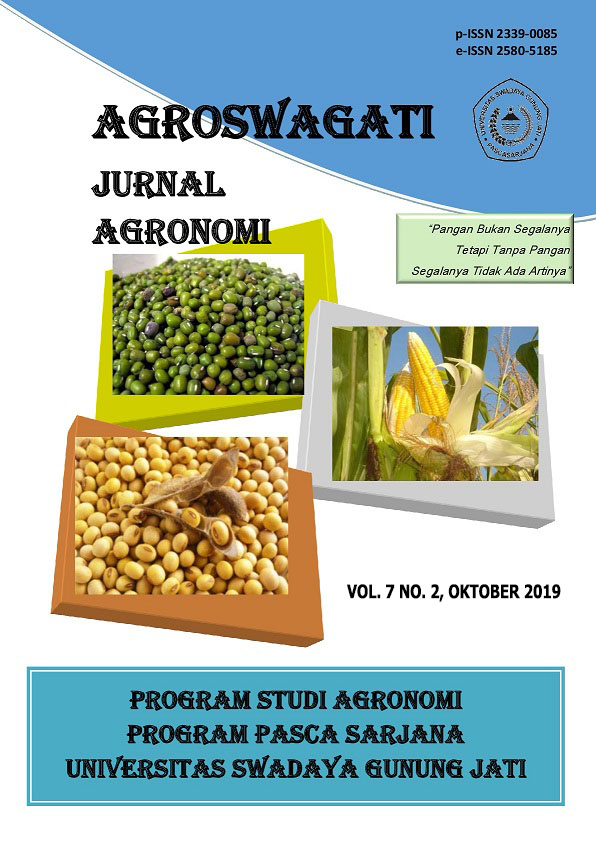PENINGKATAN PENDAPATAN PETANI PADI RAWA PASANG SURUT MELALUI PENERAPAN TEKNOLOGI RAISA DI SUMATERA SELATAN
DOI:
https://doi.org/10.33603/agroswagati.v7i2.2801Keywords:
Raisa, rice tidal swamp, farming, feasibleAbstract
Tidal swamp land has great potential and opportunities to be used as food production areas, especially rice. The IAARD has produced many technologies and varieties that are adaptive in the growing environment of tidal swamps, but their use and distribution have not been widely known and applied by farmers. The research to increase the income of tidal swamp rice farmers is intended to analyze the tidal swamp rice technology that is being developed. Research in Sukamulya Village, sub district Tungkal Ilir, District of Banyuasin, South Sumatera. The research on 2018 dry season, activities began with a pre-survey which was also used to conduct needs and opportunity studies on farmer groups who would apply tidal swamp rice cultivation technology to tidal swamp rice activities using the RAISA technology approach. Data collection is done using with and without method by means of farm record keeping. Farming analysis is used to analyze collected data. Pre-survey results, based on ranking and priority, there are 5 problems that must be immediately implemented and addressed, namely substandard irrigation, rat control, weed control, drought in the constitutional court, and fertilizer dosage. Based on the agreement, the 5 problems will be overcome by mutual cooperation on the cleaning of tertiary channels, integrated rate control, integrated weed control, planting on time, the use of water pumps, rice variety tolerant to drought, and applying fertilizer doses based on kid fertilizer. The average grain yield of farmers cooperator in tidal swamp rice farms of 5,420 kg/ha is 18.86% higher than that of non-cooperator farmers who average 4,560 kg/ha and the level of profit from tidal swamp farming in farmers cooperator is more feasible when compared to non-cooperator farmers.
References
Alihamsyah, T., M. Sarwani, dan I. Ar-Riza, 2003. Lahan pasang surut sebagai sumber pertumbuhan produksi padi masa depan. p.: 263-287 Dalam Kebijakan Perberasan dan Inovasi Teknologi Padi. Buku II. Balitpa. Puslitbang Tanm Pangan. Badan Litbang Pert.
Arsyad, M.D., Busyra B.S., dan Enrizal. 2015. Pengembangan inovasi pertanian di lahan rawa pasang surut mendukung kedaulatan pangan. ejurnal Pengembangan Inovasi Pertanian. Vol.7 No.4. Badan Litbang Pertanian.
Hariadi, M. dan Suratiyah, K. 1997. Manajemen finansial. Jur.Sosial Ekonomi Pertanian. Fak.Pertanian. UGM. Yogyakarta. (unpublished).
Husnan, S dan Suwarsono M., 2000. Studi kelayakan proyek. UPP AMP YKPN. Yogyakarta.
Ismail, I.G., I.basa, Soetjipto Ph, dan Suhud Tj. 1990. Tinjauan hasil penelitian usahatani lahan pasang surut di Sumatera Selatan. Dalam Usahatani di lahan pasang surut dan rawa. Risalah Seminar Hasil Penelitian SWAMPS-II. Bogor, 19-21 September 1989.Badan Litbang Pertanian.
Kurniawan, A.Y. 2012. Faktor-faktor yang mempengaruhi efisiensi teknis pada usahatani padi lahan pasang surut di Kecamatan Anjir Muara Kabupaten Barito Kuala, Kalimantan Selatan. Jurnal Agribisnis Pedesaan. Vol.02 No.01.Maret 2012.
Manwan, I., I.G. Ismail, Trip Alihamsyah, dan S. Partohardjono, 1992. Teknologi untuk pengembangan pertanian lahan rawa pasang surut. p.:1-17 Dalam Pengembangan Terpadu Pertanian Lahan Rawa asang Surut dan Lebak. Puslitbangtan. Bogor.
Ningsih, R.D., A. Noor. 2010. Prospek pengembangan lahan rawa sebagai sumber produksi padi di Kalimantan Selatan. Dalam Inovasi Teknologi Padi untuk Mempertahankan Swasembada dan Mendorong Ekspor Beras. Prosiding Seminar Nasional Hasil Penelitian Padi 2009 (S. Abdulrachman, H.M. Toha dan A. Gani Eds.) p: 825-840
Pramono, J., S. Basuki dan Widarto. 2005. Upaya Peningkatan Produktivitas Padi Sawah Melalui Pendekatan Pengelolaan Tanaman dan Sumberdaya Terpadu. Jurnal Agrosains, 7 (1): 1- 6.
Simatupang, R.S. dan Nurita. 2010. Teknologi olah tanah konservasi dan implementasinya dalam peningkatan produksi di lahan rawa pasang surut. Dalam Inovasi teknologi padi untuk mempertahankan swasembada dan mendorong ekspor beras. Pros.sem.nasional hasil penelitian padi 2009 (S. Abdulrachman, H.M. Toha dan A. Gani Eds.) p: 863-875.
Subagyo, H. 2006a. Klasifikasi dan penyebaran lahan rawa. hlm.1- 22. Dalam D.A. Suriadikarta, U. Kurnia, Mamat H.S., W. Hartatik, dan D. Setyorini (Ed.). Karakteristik dan Pengelolaan Lahan Rawa. Balai Besar Penelitian dan Pengembangan Sumberdaya Lahan Pertanian, Bogor.
Suwanda, H.M. dan M.Noor. 2014. Kebijakan pemanfaatan lahan rawa pasang surut untuk mendukung kedaulatan pangan nasional. Jurnal Sumberdaya Lahan. Eds khusus. Des.2014
Syahyuti, Djulin, A.M., Iqbal, M., 1998. Analisis pendekatan penyuluhan, pembentukan persepsi petani serta pengaruhnya terhadap adopsi teknologi inovasi: Kasus introduksi teknologi baru program SUTPA di Propinsi Jawa Timur dan Lampung. Prosiding Dinamika ekonomi pedesaan dan peningkatan daya saing sektor pertanian. Buku II. Pusat Penelitian Sosial Ekonomi Pertanian, Badan Litbang Pertanian.
Downloads
Published
Issue
Section
License
The Authors submitting a manuscript do so on the understanding that if accepted for publication, copyright of the article shall be assigned to Jurnal AGROSWAGATI, Sekolah Pascasarjana Ilmu Pertanian. Universitas Swadaya Gunung Jati as publisher of the journal. Copyright encompasses rights to reproduce and deliver the article in all form and media, including reprints, photographs, microfilms, and any other similar reproductions, as well as translations.
Jurnal AGROSWAGATI, Universitas Swadaya Gunung Jati and the Editors make every effort to ensure that no wrong or misleading data, opinions or statements be published in the journal. In any way, the contents of the articles and advertisements published in Jurnal AGROSWAGATIare the sole responsibility of their respective authors and advertisers.

